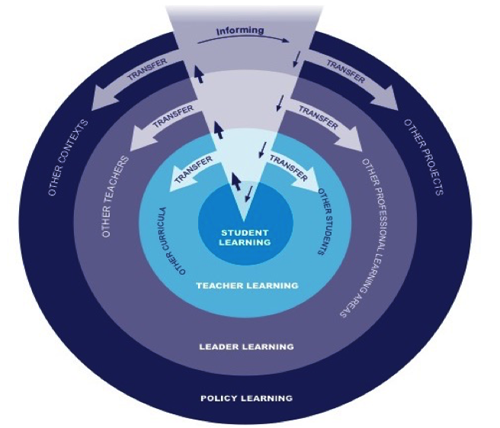Focusing
“Where will concentrating our energies make the most difference?” is the inquiry question in the focusing phase.
Leaders, teachers and learners engage in focusing to develop a deeper understanding of the situation and to agree an area to work on together.
The focusing phase may require further in-depth investigation of what is going on for specific groups of learners.
This phase of the spiral is referred to as Define your focus in the Report of the Professional Learning and Development Advisory Group (2014).
Mindsets for focusing
The most important mindset is less equals more. Focused learning equals improvement. If you try to do too many new things, then less change and improvement will happen.
What some leaders and teachers have said
“We were low in everything. We tried everything but nothing made much difference. It wasn’t until we realised that if we focused on just one thing, worked at that until we got a shift, then transferred our learning to the next thing, that we could make progress that way. It was such a relief. All the teachers are really motivated now.”
“When we really focused, we made a real difference in six weeks. We couldn’t believe it. It took us six months to realise what focusing really meant. We’re ready for the next challenge now – it won’t take six months this time.”
Number 1 rule
"Focused and deep" rather than "scattered and superficial" is the goal. Getting the "grain size" right means:
the focus is manageable. No one feels overwhelmed, – for example, place value rather than mathematics
the focus has high leverage. It is not too trivial. It really will make a difference, for example, intellectual engagement
a critical mass of staff believe that if they put in the effort it will be worth it.
Work on just one challenge at a time then transfer your learning from your successes in this challenge to addressing new and related challenges. Don’t move on until you have cracked it.
Learning in the wedge
The diagram below illustrates focused “learning in the wedge”.
- Students are at the centre of the diagram because all professional learning is based on the answer to the question “What is going on for our learners”.
- Teachers learn how to address the area of focus, with leaders learning how to work collaboratively with teachers in the same focus area. In this way they become leaders of learning.
- Once learning in the wedge is mastered, then the learning is transferred to other students, other curriculum areas, or other professional learning situations.
Leadership challenges
“I wonder if because we haven’t worked collectively we are not making any change or gains?”
Mindset challenges
- Getting sufficient commitment to a common focus. When the focus comes from understanding what is happening for learners during the scanning process it is much easier to get a common commitment. (The critical mass hardly ever includes everyone.)
- Can be a team, for example, faculty, year level, rather than a whole school – but not individual.
Organisational challenges
- Setting goals and targets that represent equitable outcomes for all students.
- Integrating your goals and targets for your inquiry focus into your annual plans. If your inquiry focus is to make a real difference it must be core business and you will need to arrange the resourcing it needs. So it must become a central part of your formal planning process rather than an add-on or afterthought.

